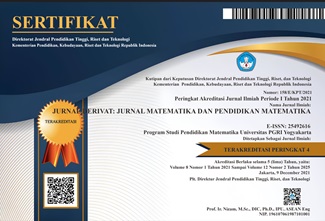Analisis Kemampuan Berpikir Kreatif Matematis Siswa Smk Pada Materi Barisan Dan Deret Di Kota Pekanbaru
DOI:
https://doi.org/10.31316/j.derivat.v6i2.500Abstract
Abstract
The ability to think mathematically creative is one of the competency standards for graduate students at the vocational level. Based on the results of previous studies said that the mathematical creative thinking ability of vocational students is very low and the interview of researchers in several mathematics teachers in Pekanbaru vocational school said that Pekanbaru vocational students were accustomed to mathematical problems according to the teacher's example and it was recognized that teachers lacked daily problems. This study aims to determine the mathematical creative thinking ability of vocational students in Pekanbaru City in row and series material. This type of research is a qualitative descriptive study. The instrument used was a mathematical creative thinking ability test with 4 indicators namely fluency, flexibility, originality and elaboration. Questions in the form of a breakdown test were taken from the SMK National Exam question bank and given to 36 students of class X TKJ-2 SMKN 2 Pekanbaru. From the test results it can be concluded that the percentage of mathematical creative thinking ability of SMKN 2 students is at the ability to think creatively enough at 42%. Where the fluency indicator is 56%, the indicator of Authenticity (originality) is 38%, the Elaboration indicator is 46% and the indicator of Flexibility is 28%.
Kata Kunci : Kemampuan Berpikir kreatif Matematis, Barisan dan Deret
Published
Issue
Section
Citation Check
License
Authors who publish with this journal agree to the following terms:
-
Authors retain copyright and grant the journal right of first publication with the work simultaneously licensed under a Creative Commons Attribution-ShareAlike 4.0 International License that allows others to share the work with an acknowledgment of the work's authorship and initial publication in this journal.
- Authors are able to enter into separate, additional contractual arrangements for the non-exclusive distribution of the journal's published version of the work (e.g., post it to an institutional repository or publish it in a book), with an acknowledgment of its initial publication in this journal.
- Authors are permitted and encouraged to post their work online (e.g., in institutional repositories or on their website) prior to and during the submission process, as it can lead to productive exchanges, as well as earlier and greater citation of published work (See The Effect of Open Access).







